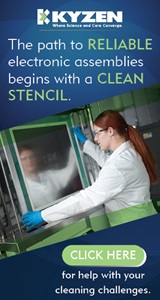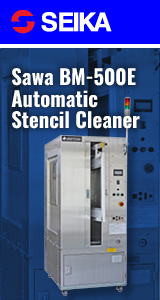|

|
|
| Ask the Experts | |||||||
|
|||||||
|
October 20, 2017 - Updated September 2, 2008 - Originally Posted Does Lead Free Flux Make a Difference?Does using a lead free solder flux really make a difference? Why not use the same flux we use for leaded soldering in our lead free process? T. F. |
|||||||
| Expert Panel Responses | |||||||
|
Fluxes do not contain metals, such as lead, so all fluxes are lead free. Your question must be asking about flux that is marketed as being specially formulated for use with lead free alloy. The answer is: you will not know unless you try it. Notall lead free alloys work equally well with all fluxes. Flux can be formulated to achieve superior results with aspecific lead free alloy. When claims such as this are made, I recommend contacting the manufacturer and asking for a FREE sample so you can prove to yourself that their claim is valid. Be sure to evaluate the qualities of the residue when you do your testing. Some "lead free" fluxes just have higher activity levels to compensate for the moredifficult wetting andhigher reflow temperature. In some cases with no-clean fluxes, a certain minimum reflow time is required to consume their activator so the residue is in fact no-clean.
Application Engineering Supervisor Nordson EFD Mr. Vivari has more than 15 years of electronic engineering design and assembly experience. His expertise in fluid dispensing and solder paste technology assists others in identifying the most cost effective method for assembling products.
Lead-free alloys wet slower, have a greater surface tension, and operate at higher temperatures compared to tin/lead. There are older chemistries which work with lead-free alloys, but they are typically not an optimal choice. A flux which has been specifically developed for lead-free applications, is by design capable of accommodating the demands these alloys make on the soldering process, thus providing a more optimal process window for the end user.
President FCT Assembly Mike Scimeca created FCT Assembly after the purchase of Fine Line Stencil, Inc., and consists of two major operations: stencil manufacturing and the manufacturing of electronic assembly products such as solder paste, flux and solder bar.
General Manager - Electronic Assembly Americas DEK International Mr. Smith has been supporting customers in the electronics assembly industry since 1994. His expertise is focused on solder paste printing and reducing soldering defects. He holds a BS in Chemical Engineering and an MBA in Marketing. He has authored several papers in trade magazines and at industry conferences. He is an SMTA Certified Process Engineer.
Yes, due to the higher reflow temperatures and longer soak times if you tried to use eutectic flux in a lead free application the fluxes would activate too soon in the cycle and not be available during the reflow of the solder joint.
Regional Sales Manager OK International Inc. Ed Zamborsky is a Regional Sales & Technical Support Manager for Thermaltronics, located in New York. His position requires frequent customer visits throughout North America and the Caribbean and his position encompasses not only sales but the role of trainer and master applications engineer for all of Thermaltronics products. His expertise includes such specialties as hand soldering, convection and conduction reflow techniques, array rework, fluid dispensing equipment, and fume extraction. Ed has authored many articles and has presented many papers on topics such as; Low Volume SMT Assembly, Solder Fume Extraction, SMT Rework, BGA Rework, Lead-Free Hand Soldering, High Thermal Demand Hand Soldering, Lead Free Visual Inspection and Lead Free Array Rework.
|
|||||||
| Submit A Comment | |||||||
|
Comments are reviewed prior to posting. You must include your full name to have your comments posted. We will not post your email address. |
|
Free Newsletter Subscription
Circuitnet is built for professionals who bear the responsibility of looking ahead, imagining the future, and preparing for it. Insert Your Email Address |
|

|






